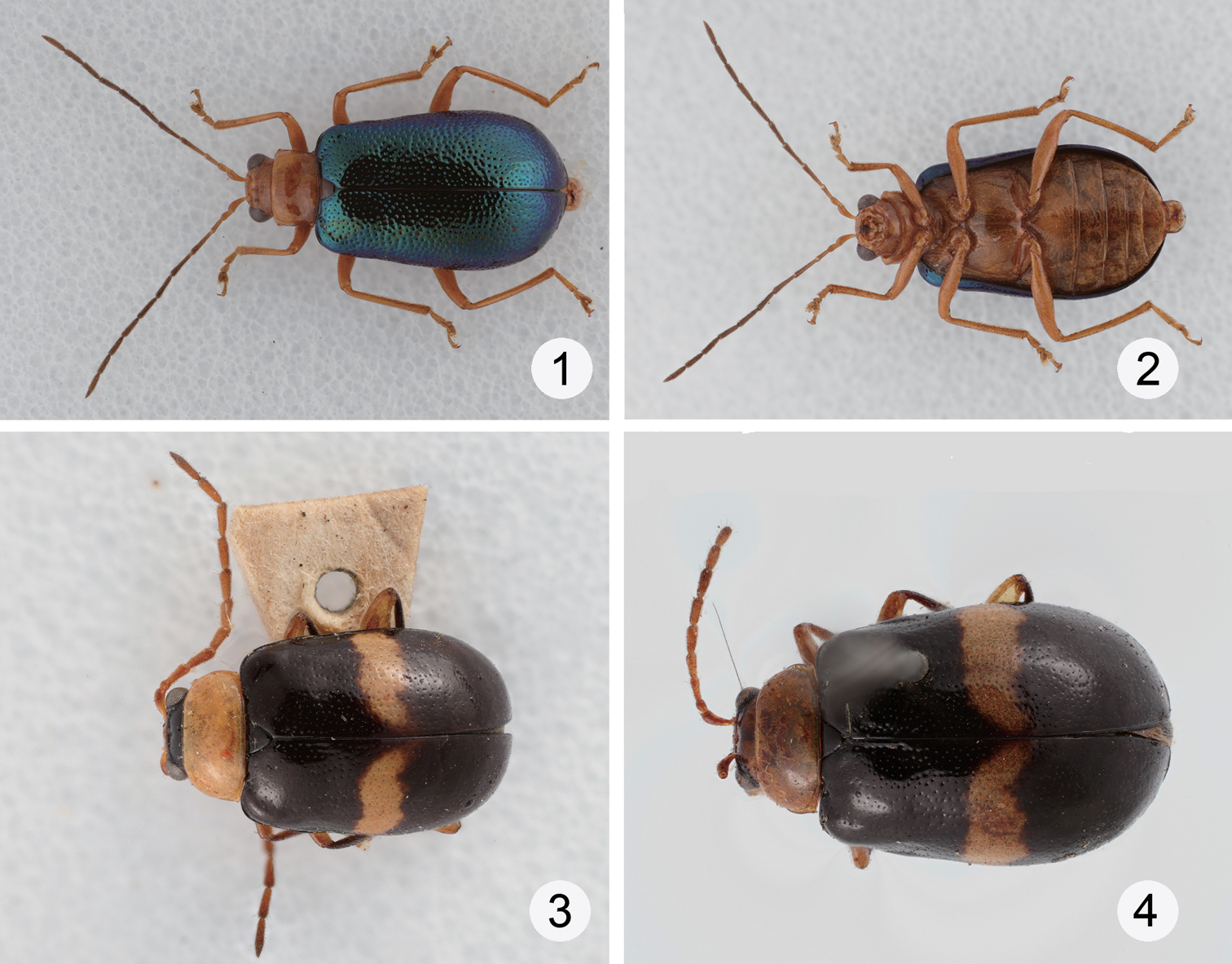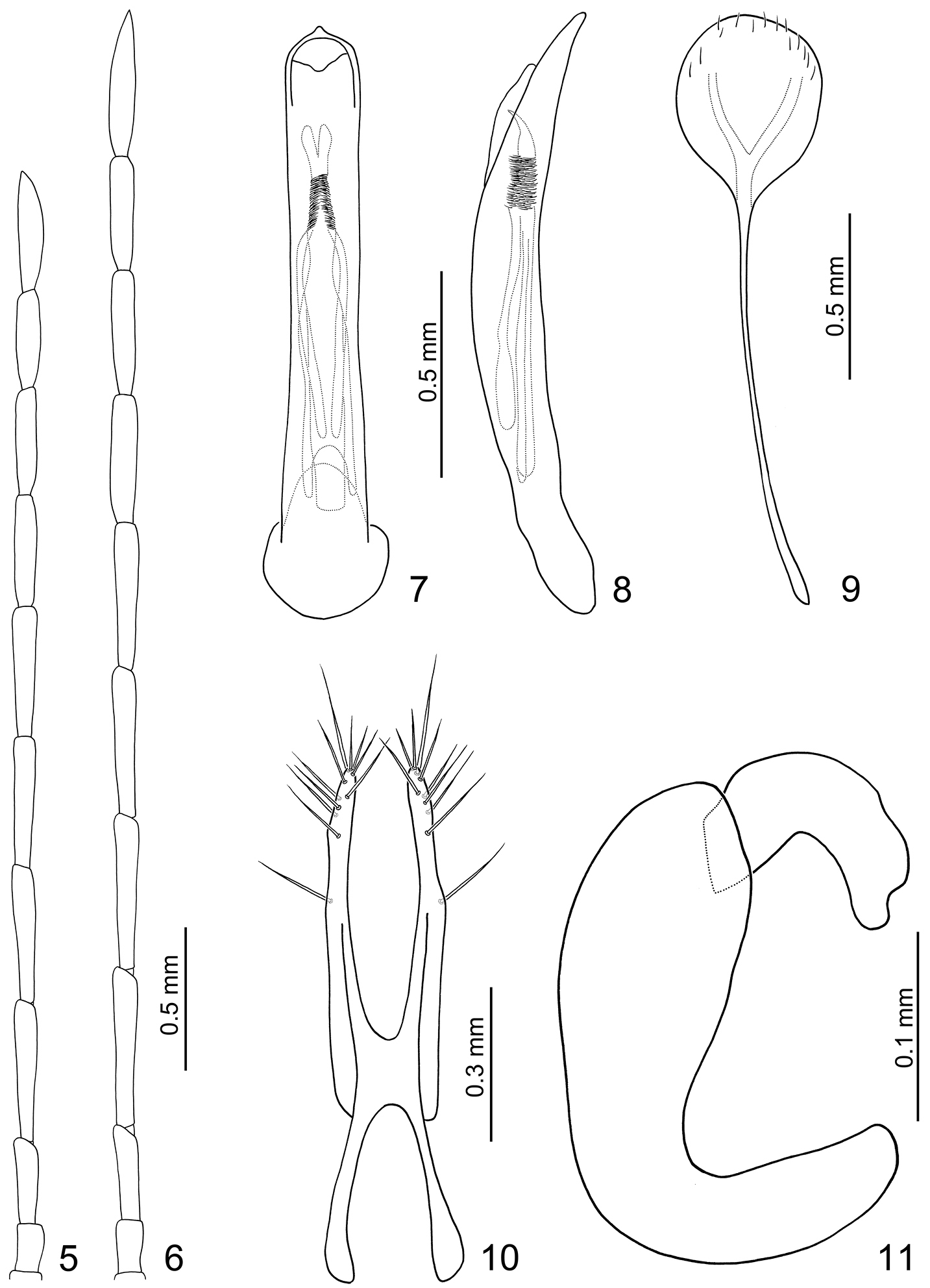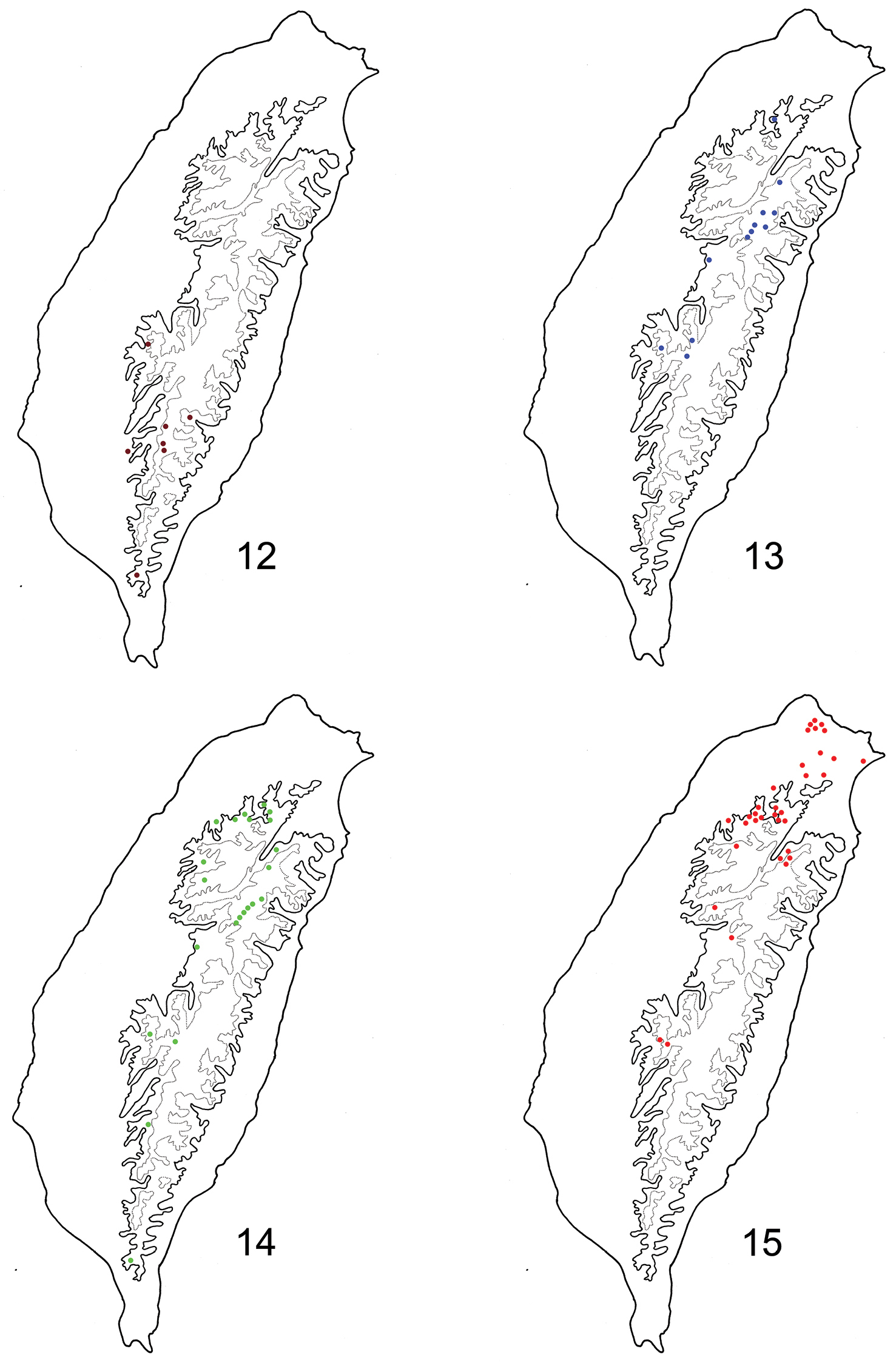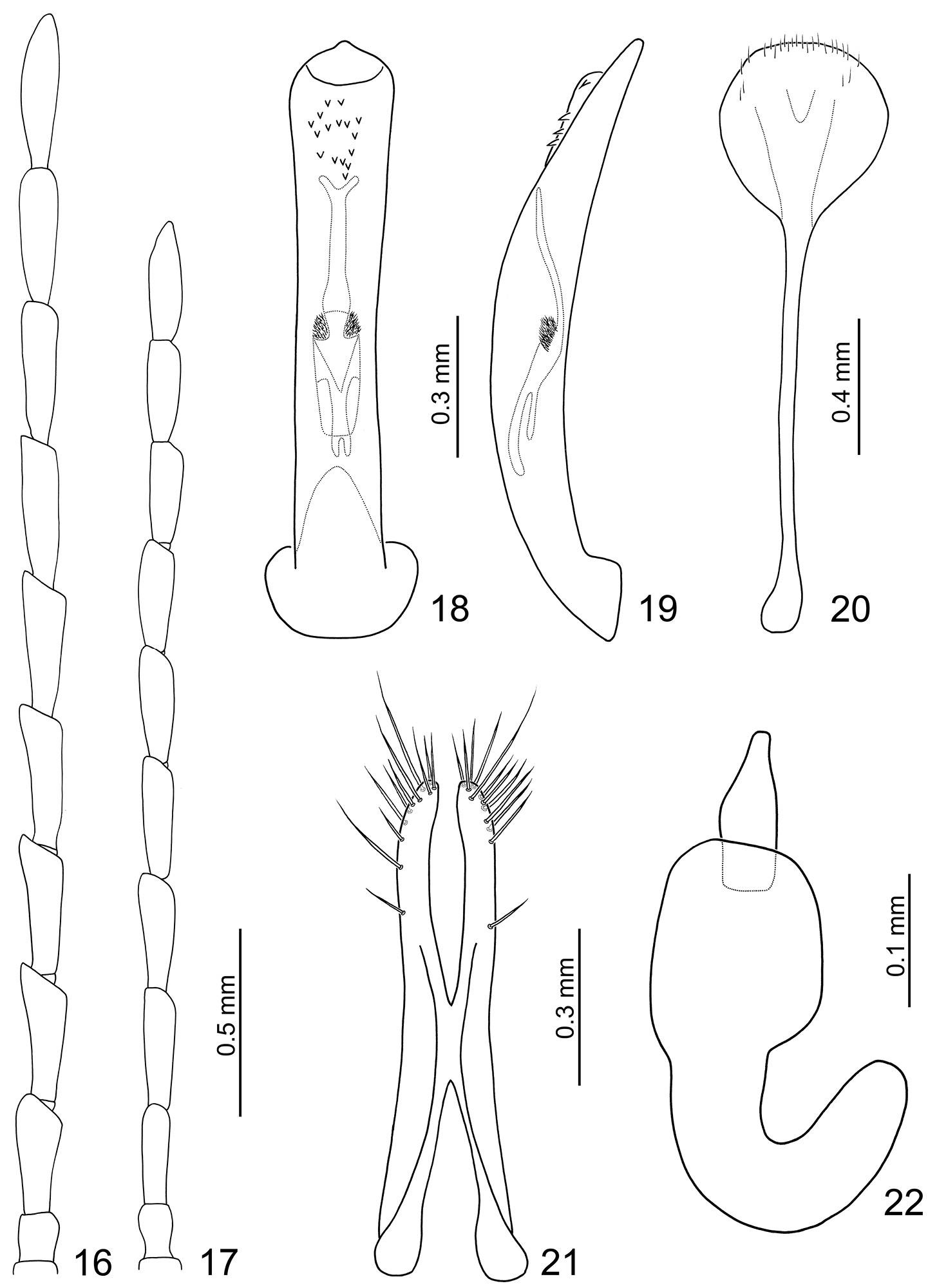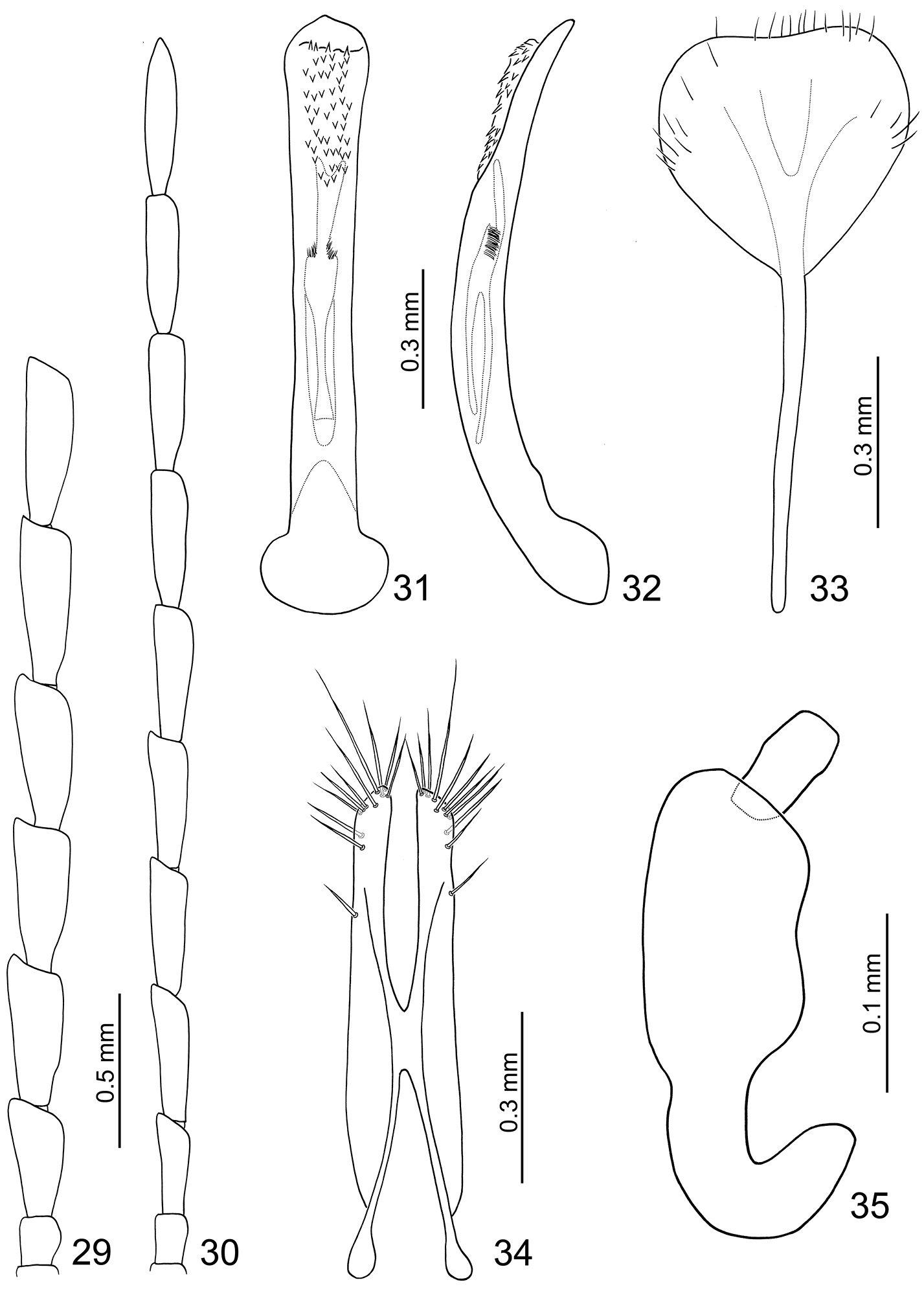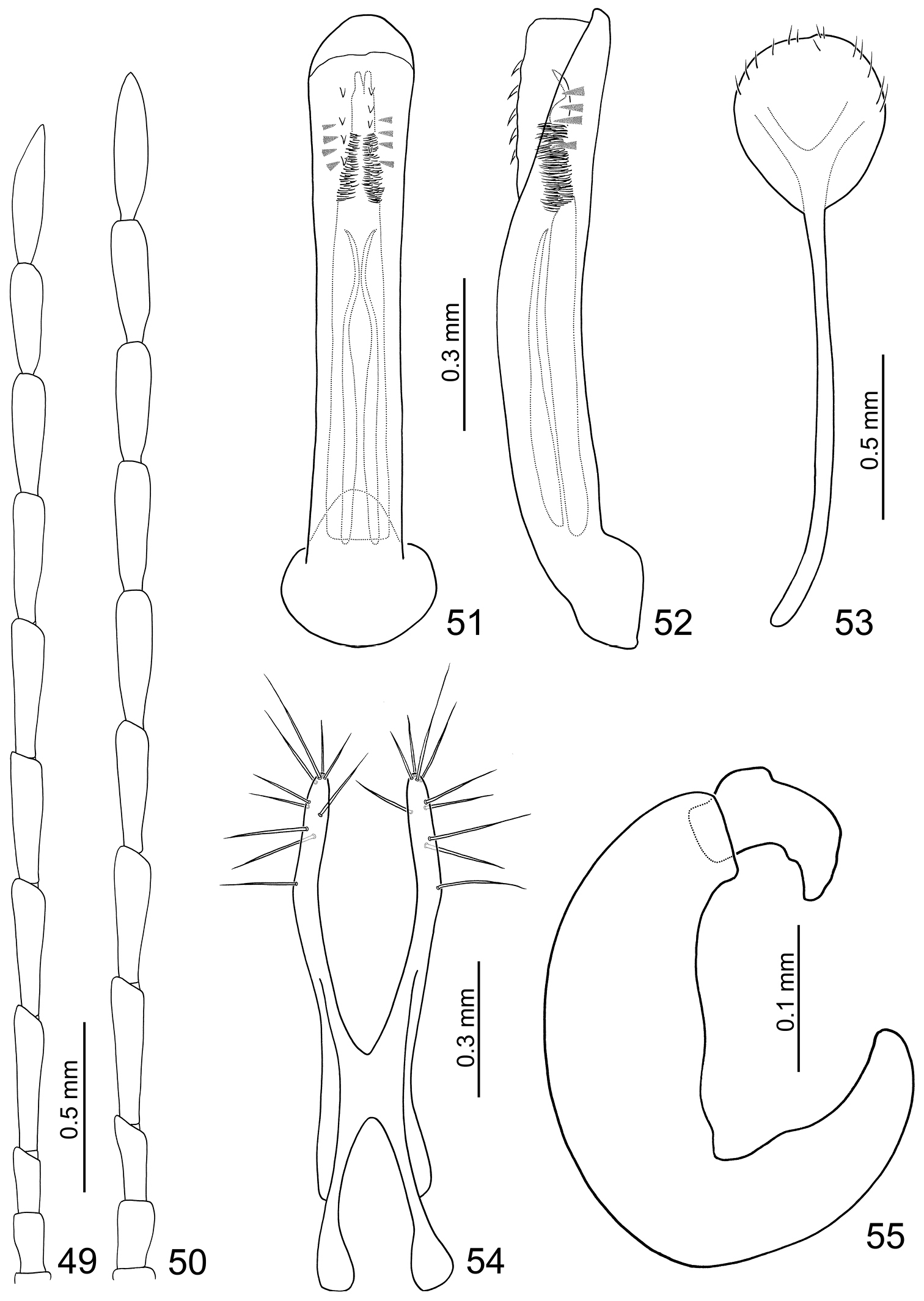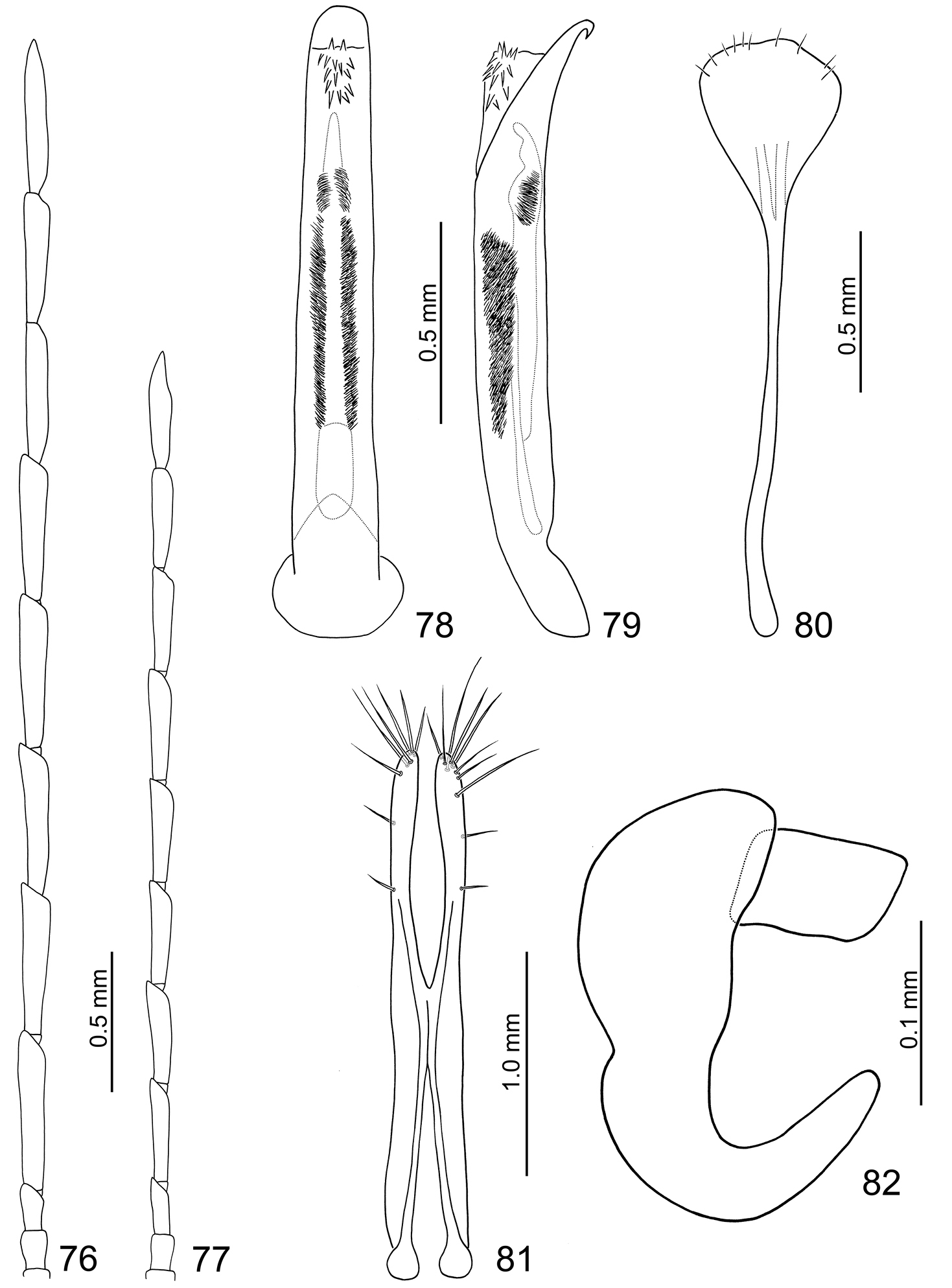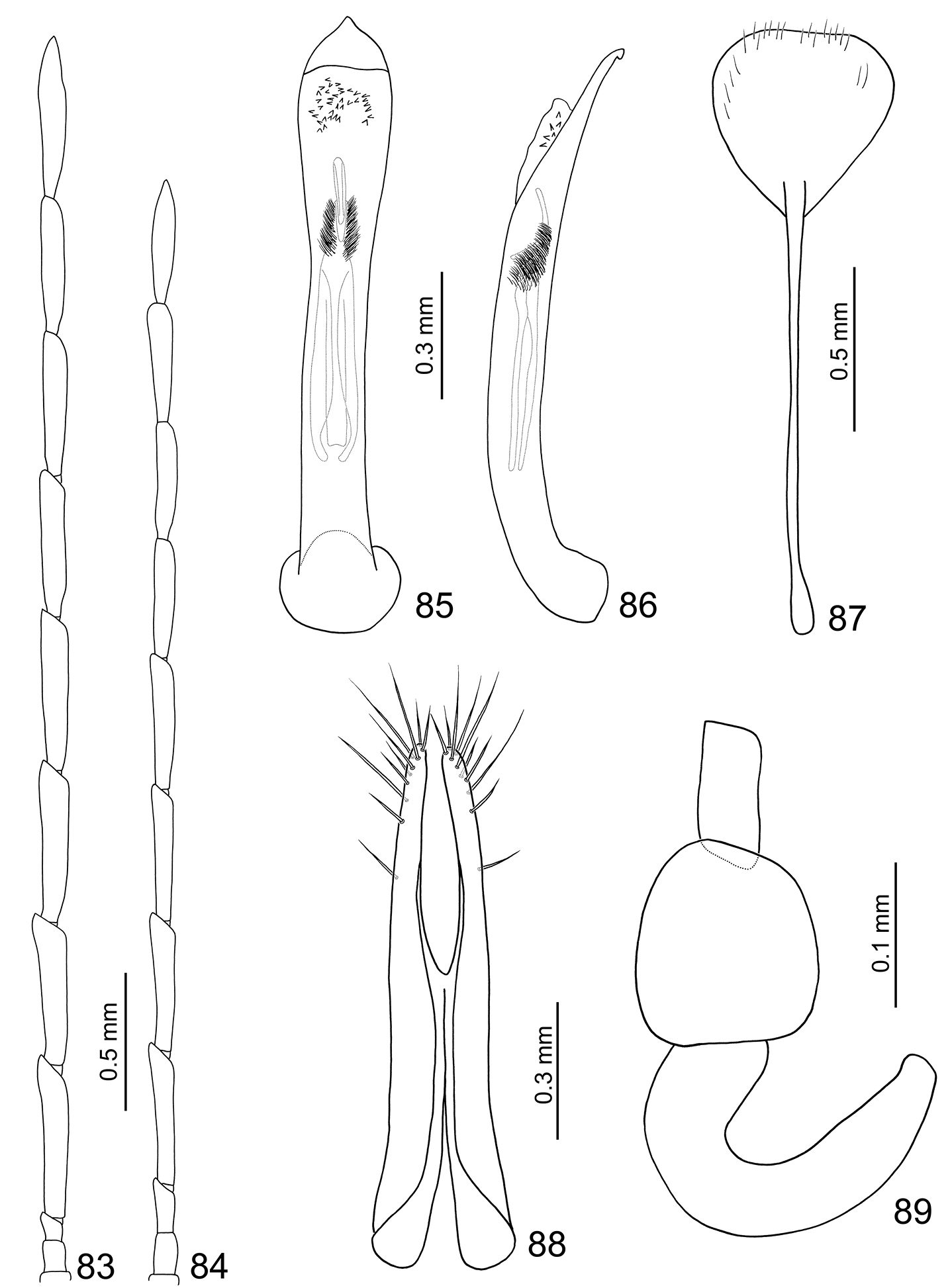






(C) 2013 Chi-Feng Lee. This is an open access article distributed under the terms of the Creative Commons Attribution License 3.0 (CC-BY), which permits unrestricted use, distribution, and reproduction in any medium, provided the original author and source are credited.
For reference, use of the paginated PDF or printed version of this article is recommended.
Citation: Lee C-F, Bezděk J (2013) Revision of the genus Dercetina from Taiwan and their similar species, with description of a new species from Myanmar (Insecta, Chrysomelidae, Galerucinae). ZooKeys 323: 1–33. doi: 10.3897/zookeys.323.5195
Species of the genus Dercetina Gressitt & Kimoto, 1963 in Taiwan are revised. Dercetina azumai Gressitt and Kimoto, 1966, Dercetina itoi Kimoto, 1969, and Dercetina shirozui Kimoto, 1969 are redescribed. Dercetina chinensis (Weise, 1889), Dercetina taiwana (Chûjô, 1938), and Dercetina unifasciata (Allard, 1889) are removed from synonymy with Dercetina flavocincta (Hope, 1831). Dercetina flavocincta and Dercetina nakanei Kimoto, 1969 are transferred to the genus Arthrotus Motschulsky, 1858. Lectotypes are designated for Dercetis taiwana Chûjô, 1938, and Antipha varipennis Jacoby, 1890. The synonymies of Antipha flavofasciata Baly, 1879 and Dercetes femoralis Weise, 1922 with Arthrotus flavocincta (Hope, 1831), Antipha varipennis Jacoby, 1890 with Dercetina chinensis (Weise, 1889) are supported. A new species, Dercetina barclayi sp. n. which was confused with Dercetina flavocincta, is described from Myanmar.
Dercetina, Arthrotus, Taiwan, taxonomic revision
Dercetina Gressitt & Kimoto, 1963 is very similar to the genus Arthrotus Motschulsky, 1858. These genera differ from each other only by the structure of male antenna: the antennomere III is about twice longer than antennomere II in Dercetina, while antennomeres II and III are subequal in length in Arthrotus. Thus females are impossible to assign to either genus if they are not associated with males. Moreover, most members of Dercetina have similar shapes of male aedeagi and some species have great color variation. These factors have caused taxonomic confusion in Dercetina and Arthrotus. To solve this problem, examination of extensive collections and evaluation of characters other than the external morphology of the male aedeagi are necessary. The examination of endophallic sclerites, which we studied here for the first time in Dercetina and Arthrotus, seems to be very helpful for resolving many taxonomical problems in both genera.
Dercetina is an Asian genus and comprises 88 species (
Dercetina taiwana (Chûjô, 1938) has a complicated nomenclatural history. It was synonymized with Dercetina chinensis (Weise, 1889) by
To study specimens and prepare drawings of the adult reproductive systems, the abdomens of adults were separated and boiled in a 10% KOH solution, cleared in distilled water, and then mounted on slides with glycerin. Slides were examined using a Leica M165 stereomicroscope, and figures were drawn using a Nikon ECLIPSE 50i microscope.
Studied specimens have been deposited at the following institutes and museums and
BMNH The Natural History Museum, London, UK [Maxwell V. L. Barclay]
BPBM Bernice P. Bishop Museum, Honolulu, USA [Shepherd Myers]
ISNB Institut royal des Sciences Naturelles de Belgique, Bruxelles, Belgium [Pol Limbourg]
KMNH Kitakyushu Museum of Natural History and Human History, Kitakyushu, Japan [Kyoichiro Ueda]
KUEC Faculty of Agriculture, Kyushu University, Fukuoka, Japan [Osamu Tadauchi]
MCZC Museum of Comparative Zoology, Harvard University, Massachusetts, USA [Philip D. Perkins]
MNHUB Museum für Naturkunde, Leibniz-Institut für Evolutions- und Biodiversitätsforschung an der Humboldt-Universität zu Berlin, Berlin, Germany [Joachim Willer, Johannes Frisch]
NHRS Naturhistoriska Riksmusset, Stockholm, Sweden [Johannes Bergsten]
SDEI Senckenberg Deutsches Entomologisches Institut, Müncheberg, Germany [Stephan Blank]
TARI Taiwan Agricultural Research Institute, Taichung, Taiwan.
USNM National Museum of Natural History, Smithsonian Institution, Washington DC, USA [Alexander Konstantinov]
http://species-id.net/wiki/Dercetina_azumai
Dercetina azumai: Holotype ♀ (KUEC): “RYUKYU IS. Iriomote I. Ushiku-mori 11.III.1964 / S. Kimoto Collector / Japan-U. S. Co-op. Sci. Programme (yellow label) / HOLOTYPE DERCETINA AZUMAI J. L. GRESSITT (red label)”.
TAIWAN: 1♂, Kaoshiung, Chuyunshan trail, 1.III.2009, leg. U. Ong (TARI); 1♀, Kaoshiung, Taoyuan, 3.VII.2009, leg. S.-F. Yu (TARI); 5♂♂, 12♀♀, Kaoshiung, Tengchih (= Shihshan trail), 2-5.VI.2008, leg. C.-F. Lee (TARI); 3♂♂, 16♀♀, same locality, 2.X.2008, leg. M.-H. Tsou (TARI); 6♀♀, same locality, 1–3.X.2008, leg. M.-H. Tsou (TARI); 1♂, 1♀, same locality, 5.II.2009, leg. M.-H. Tsou (TARI); 1♂, 1♀, same locality, 26.V.2009, leg. C.-F. Lee (TARI); 1♂, same locality, 4.VII.2011, leg. M.-H. Tsou (TARI); 1♀, Pingtung, Jinshuiying, 12.IV.2012, leg. C.-F. Lee (TARI); 2♀♀, Pingtung, Tahanshan, 22.I.2009, leg. S.-F. Yu (TARI); 1♀, same locality, 24.I.2009, leg. M.-H. Tsou (TARI); 1♀, same locality, 8.V.2009, leg. U. Ong (TARI); 1♂, same locality, 21.VII.2009, leg. J.-C. Chen (TARI); 6♂♂, 14.VIII.2011, leg. Y.-T. Wang (TARI); 1♀, same locality, 6.VI.2012, leg. C.-F. Lee (TARI); 1♂, same locality, 19.VII.2012, leg. C.-F. Lee (TARI); 2♂♂, Taitung, Motien, 23.VI.2010, leg. S.-F. Yu (TARI); 1♂, same locality, 19.VI.2011, leg. C.-F. Lee (TARI).
Dercetina azumai is similar to Dercetina shirozui with metallic green elytra but differs by the yellowish brown head, prothorax, meso- and metathoracic ventrites (in contrast with metallic green head, prothorax, meso- and metathoracic ventrites in Dercetina shirozui).
Color (Figs 1–2) yellowish brown except eye black; antennomeres III-XI dark brown; elytron metallic green or blue. Head shagreened and impunctate. Pronotum transverse, 1.4–1.5 times wider than long, disc with a pair of deep fovea, and scattered prominent and fine punctures; lateral margin sinuate, narrowed posterior, anterior margin slightly concave, posterior margin slightly rounded. Elytra more or less widened posterior, apex convergent rounded, 1.6–1.7 times longer than wide, disc with densely prominent punctures; epipleurae with scattered prominent prunctures.
Habitus of Dercetina species. 1 Dercetina azumai, dorsal view 2 Dercetina azumai, ventral view 3 Dercetina barclayi sp. n., dorsal view 4 Dercetina barclayi sp. n., ventral view.
Male. Length 4.9–5.6 mm, width 2.1–2.4 mm. Antenna filiform (Fig. 5), ratio of length of antennomeres III to XI about 1.0: 1.6: 1.6: 1.6: 1.6: 1.3: 1.2: 1.1: 1.4; ratio of length to width of antennomeres III to XI about 3.9: 6.4: 6.1: 6.0: 6.2: 5.1: 4.8: 4.1: 5.1. Penis (Fig. 7) extremely slender, about 8.9 times longer than wide, parallel-sided, basally widened, apex pointed; tectum membranous, with scattered stout membranous setae; weakly curved in lateral view (Fig. 8); endophallic sclerite elongate, about 0.7 times as long as penis, apex curved in lateral view, bifurcate, with a cluster of dense setae near apex; a pair of hooked dorsal slclerite connected at apical 1/5, an elongate sclerite between dorsal sclerite and ventral sclerite, connected at apical 1/3; ventral sclerite with base deeply bifurcate.
Dercetina azumai. 5 Antenna, male 6 Antenna, female 7 Aedeagus, dorsal view 8 Aedeagus, lateral view 9 Sternite VIII 10 Gonocoxae 11 Spermatheca.
Female. Length 5.5–6.8 mm, width 2.6–3.3 mm. Ratio of length of antennomeres III to XI about 1.0: 1.7: 1.6: 1.6: 1.5: 1.4: 1.3: 1.3: 1.5; ratio of length to width of antennomeres III to XI about 3.8: 6.3: 6.1: 5.9: 5.6: 5.1: 4.9: 4.9: 5.7 (Fig. 6). Sternite VIII (Fig. 9) weakly sclerotized laterally and apically, with scattered setae along lateral and apical margin, spiculum extremely slender. Spermathecal receptaculum (Fig. 11) weakly swollen; pump narrow and moderately curved, apex broadly rounded; spermathecal duct long, strongly curved, deeply projecting into receptaculum. Gonocoxae (Fig. 10) widely connected at middle, about 4.4 times longer than wide, curved inwards at apical 1/3, with one long seta at apical 1/3, eleven setae at apex.
Myrsinaceae: Embelia lenticellata Hayata; Saxifragaceae: Hydrangea angustipetala Hayata.
Japan (Iriomote island) and Taiwan. This species occurs in mountains (1000–2000 m) of southern Taiwan (Fig. 12) but locally abundant.
Distribution map of Dercetina species, solid line: 1000 m, broken line: 2000 m. 12 Dercetina azumai 13 Dercetina itoi 14 Dercetina shirozui 15 Dercetina taiwana.
Holotype ♂ (BMNH): “Doherty / Birmah RubyMes / Fry Coll. 1905. 100.”. Paratypes: 1♂, same as holotype (BMNH); 1♂, 2♀♀: “Ruby Mines. Burma. 5.500 to 7.500 ft. 1904-150.” (BMNH); 4♂♂, 1♀: “Ruby Mines U. M. / Gift of F. G. Bowditch” (USNM).
This new species is similar to Dercetina taiwana but differs by yellowish brown antennae, no color variation, wider penis, and with longer endophallic sclerites.
Color (Figs 3–4) bluish black, prothorax, coxae, and tibiae yellowish brown; elytron with one trasverse white stripe at basal 1/3; head brown, vertex and labium black. Head smooth and impunctate. Pronotum transverse, 2.2 times wider than long, evenly convex on disc and lacking fovea or punctured depression, disc with scattered fine punctures; lateral margin rounded, anterior margin slightly concave, posterior margin straight. Elytra more or less widened posteriorly, apex convergently rounded, 1.4-1.5 times longer than wide, disc with punctures in part arranged in longitudinal rows, epipleurae smooth and impunctate.
Male. Length 3.9–4.3 mm, width 2.1–2.4 mm. Antennomeres III-X weakly serrate (Fig. 16), ratio of length of antennomeres III to XI about 1.0: 1.2: 1.2: 1.2: 1.2: 1.2: 1.1: 1.1: 1.3; ratio of length to width of antennomeres III to XI about 2.6: 3.0: 3.3: 3.4: 3.4: 3.9: 3.8: 3.7: 4.8. Penis (Fig. 18) extremely slender, about 7.3 times longer than wide, parallel-sided, basally and apically widened, apex narrowly rounded; tectum membranous, with scatted stout setae; weakly curved in lateral view (Fig. 19); endophallic sclerites elongate, about 0.5 times as long as penis, dorsal sclerite with base bifurcate, apex truncate; ventral sclerite much longer than dorsal sclerite, apex bifurcate, base rounded, with a cluster of short setae at middle; in lateral view moderately curved.
Dercetina barclayi sp. n. 16 Antenna, male 17 Antenna, female 18 Aedeagus, dorsal view 19 Aedeagus, lateral view 20 Sternite VIII 21 Gonocoxae 22 Spermatheca.
Female. Length 4.7–5.3 mm, width 2.8–3.1 mm. Antenna 11-segmented, antennomeres III-X weakly serrate (Fig. 17), comparatively narrower than male, ratio of length of antennomeres III to XI about 1.0: 1.2: 1.2: 1.2: 1.2: 1.2: 1.0: 1.0: 1.2; ratio of length to width of antennomeres III to XI about 3.2: 3.6: 3.4: 3.6: 3.5: 3.3: 3.0: 3.2: 3.8. Sternite VIII (Fig. 20) weakly sclerotized subapically, apex rounded, with dense short setae along lateral and apical margin, spiculum long. Spermathecal receptaculum (Fig. 22) strongly swollen; pump narrow and strongly curved, apex widely rounded; spermathecal duct short, deeply projecting into receptaculum. Gonocoxae (Fig. 21) narrowly connected in middle, about 5.5 times longer than wide, slightly curved inwards near apex, apex rounded, with one short setae at apical 1/3, ten to eleven setae at apex.
This new species is named for Maxwell V. L. Barclay who is one of Britain’s leading entomologists and curator of Coleoptera at the Natural History Museum in London.
Only known from the type locality.
http://species-id.net/wiki/Dercetina_chinensis
Arthrotus chinensis: Holotype ♀ (MNHUB): “Yunnan Fischer / Yünnan Fischer / Arthrotus chinensis 89., m. / Typus (red label) / Arthrotus chinensis Wse L. N. Medvedev det. 1987”. Although locality labels of the holotype didn’t fit the original description, where Peking is clearly indicated, we prefer to treat it as true holotype because the specimen perfectly fit the original description and bears also original Weise´s handwritten identification label.
Antipha varipennis: Lecotype ♂ (BMNH), here designated, labeled: “Chang Yang A. E. Pratt Coll. July 1888. / Jacoby Coll. 1909-28a / varipennis Jac”. Paralectotypes: 1♂ (BMNH), same with lecotype but without determination label; 2♂♂ with black elytra and same labels are not designated as paralectotypes since
Dercetina chinensis is similar to Dercetina taiwana by the absence of lateral fovea on the pronotum and by the antennomere IV being slightly longer than III. It can be distinguished by its characteristic color patterns (yellowish brown elytra with black longitudinal bands along suture and lateral margins) and oblong elytra (1.6 times longer than wide in contrast to 1.4 times longer than wide in Dercetina taiwana).
Color very variable, in pale individuals generally yellowish brown, antennae, apical 2/3 of tibiae, and tarsi dark brown, meso- and metathoracic and abdominal ventrites blackish brown, margin of scutellum, and suture and lateral margins of elytra darkened (Fig. 23); in darker individuals black areas on elytra expanding inside, scutellum blackish brown, and head sometimes darkened (Fig. 24); in some individuals entire elytra black (Fig. 25); in darkest individuals entire body black (Fig. 26). Head smooth and impunctate. Pronotum transverse, 1.8 times wider than long, evenly convex on disc and lacking fovea or punctured depression, disc with scattered fine punctures; lateral margin rounded, anterior margin slightly concave, posterior margin slightly rounded. Elytra parallel-sided, apex convergently rounded, 1.6 times longer than wide, disc with random punctures, epipleurae smooth and impunctate.
Habitus of Dercetina species. 23 Dercetina chinensis, pale individual 24 Dercetina chinensis, pale individual 25 Dercetina chinensis, dark individual 26 Dercetina chinensis, dark individual 27 Dercetina itoi, dorsal view 28 Dercetina itoi, ventral view.
Male. Length 4.7–5.2 mm, width 2.4–2.8 mm. Atennomere II as long as antennomere III, ratio of length of antennomeres III to VIII (IX–XI lost) about 1.0: 1.3: 1.3: 1.3: 1.5: 1.5; ratio of length to width of antennomeres III to VIII about 2.3: 2.7: 2.9: 3.3: 3.5 (Fig. 29). Penis (Fig. 31) extremely slender, about 10.6 times longer than wide, parallel-sided, basally and apically widened; apex narrowly rounded, with small process in middle; tectum membranous, with dense stout setae; moderately curved in lateral view (Fig. 32); endophallic sclerites elongate, about 0.5 times as long as penis, apex concave and membranous, with a dorsal sclerite connected at middle, almost reaching base, with a row of short setae along lateral margin at apical 1/3; in lateral view almost straight.
Dercetina chinensis. 29 Antenna, male 30 Antenna, female 31 Aedeagus, dorsal view 32 Aedeagus, lateral view 33 Sternite VIII 34 Gonocoxae 35 Spermatheca.
Female. Length 4.5 mm, width 2.5 mm. Antenna comparatively narrower than male (Fig. 30), ratio of length of antennomeres III to XI about 1.0: 1.3: 1.3: 1.3: 1.3: 1.3: 1.3: 1.3: 1.6; ratio of length to width of antennomeres III to XI about 2.9: 3.4: 3.5: 3.5: 3.5: 4.0: 4.0: 4.0: 4.9. Sternite VIII (Fig. 33) very small, weakly sclerotized subapically, setae along lateral and apical margins, spiculum short. Spermathecal receptaculum (Fig. 35) strongly swollen; pump narrow and strongly curved, apex narrowly rounded; spermathecal duct short and stout, shallowly projecting into receptaculum. Gonocoxae (Fig. 34) narrowly connected in middle, elongate, about 4.7 times longer than wide, slightly curved inwards at apical 1/4, with one short setae at apical 1/3, ten short and long setae located apically or subapically.
China (Yunnan).
http://species-id.net/wiki/Dercetina_itoi
Holotype ♀ (KUEC): “(Taiwan) Alishan, 2300m Chiayi Hsien / 6.vii.1965 S. Ito / Japan-U. S. Co-op. Sci. Programme (yellow label) / HOLOTYPE (red label) / Dercetina itoi Kimoto, n. sp.”. Paratypes: 1 ex. (KMNH): “(Taiwan) Sungkang Nantou Hsien / 31.v.1965 T. Shirôzu / PARATYPE (blue label) / Dercetina itoi Kimoto, n. sp.”; 1 ex. (KMNH): “(Taiwan) Sungkang, 2000m – Tsuifeng, 2300m Nantou Hsien / 29.vi.1965 S. Kimoto / Japan-U. S. Co-op. Sci. Programme (yellow label) / PARATYPE (blue label) / Dercetina itoi Kimoto, n. sp.”; 1 ex. (KMNH): “[Formosa] Oiwake (Tsuifeng in Nantou county) 2, 300 m 4.V.1965 T. Shirôzu / PARATYPE (blue label) / Dercetina itoi Kimoto, n. sp.”.
TAIWAN: 6♂♂, 4♀♀, Ilan, Ssuyuan, 25.IV.2009, leg. C.-F. Lee (TARI); 6♂♂, 12♀♀, same locality, 25.IV.2009, leg. M.-H. Tsou (TARI); 1♀, same locality, 9.VI.2009, leg. S.-F. Yu (TARI); 1♀, same locality, 6.V.2011, leg. S.-F. Yu (TARI); 1♀, Hohuanshan, 17.V.2009, leg. C.-F. Lee (TARI); 1♀, Nantou, Meifeng, 7–9.V.1981, leg. K. S. Lin & S. C. Lin (TARI); 1♀, same locality, 24–26.VI.1981, leg. K. S. Lin & W. S. Tang (TARI); 1♀, same locality, 22.V.1982, leg. L. Y. Chou (TARI); 1♀, same locality, 3.VII.2008, leg. M.-H. Tsou (TARI); 1♂, same locality, 20.IV.2011, leg. C.-F. Lee (TARI); 2♂♂, 2♀♀, same locality, 30.V.2011, leg. M.-H. Tsou (TARI); 1♀, Nantou, Tatachia, 9.VI.2009, leg. C.-F. Lee (TARI); 1♂, same locality, 20.VII.2009, leg. S.-F. Yu (TARI); 1♂, same locality, 21.IX.2009, leg. C.-F. Lee (TARI); 1♂, 4♀♀, same locality, 17.V.2010, leg. C.-F. Lee (TARI); 1♂, Nantou, Tsuifeng, 3.VI.1980, leg. L. Y. Chou & C. C. Chen (TARI); 2♂♂, 6♀♀, same locality, 8.V.1981, leg. K. S. Lin & S. C. Lin (TARI); 2♀♀, same locality, 25–27.VI.1981, leg. K. S. Lin & W. S. Tang (TARI); 1♂, 4♀♀, same locality, IV.1984, leg. K. S. Lin & K. C. Chou (TARI); 1♀, same locality, 23.VII.1984, leg. K. S. Lin (TARI); 2♂♂, 3♀♀, Nantou, Tungfu, 8.V.2011, leg. C.-F. Lee (TARI); 2♂♂, Nantou, Musha (= Wushe), 18.V.-15.VI.1919, leg. T. Okuni (TARI); 2♀♀, same locality, 6–11.V.1981, leg. K. S. Lin & S. C. Lin (TARI); 4♂♂, 3♀♀, Taichung, Pilu, 17.V.2009, leg. C.-F. Lee (TARI); 6♂♂, same locality, 17.V.2009, leg. M.-H. Tsou (TARI); 2♂♂, 1♀, Taoyuan, Lalashan, 1–2.IV.2009, leg. C.-F. Lee (TARI); 2♀♀, same locality, 14.V.2009, leg. C.-F. Lee (TARI).
Dercetina itoi is characterized by its metallic purple color. Some individuals of Dercetina shirozui with blackish brown legs are similar to Dercetina itoi in color pattern. Dercetina itoi can be separated from Dercetina shirozui by the tiny punctures on the pronotum (in contrast with the prominent puncures on the pronotum in Dercetina shirozui).
Color (Figs 3–4) dark metallic purple, antennae and legs blackish brown, abdomen yellowish brown. Antennal calli separated by deep furrow; vertex with distinct punctures, disc shagreened. Pronotum 1.6–1.7 times wider than long, disc evenly convex, with scattered fine punctures, and a pair of deep round fovea at sides; lateral margin straight, narrowed posteriorly, anterior margin straight, posterior margin slightly rounded. Elytra more or less widened posteriorly, apex convergently rounded, 1.6–1.7 times longer than wide, disc with densely prominent punctures; epipleurae impunctate, somewhat rugose.
Male. Length 5.1–5.3 mm, width 2.4–2.6 mm., Antennomeres VIII-XI filiform, ratio of length of antennomeres III to XI about 1.0: 1.5: 1.4: 1.3: 1.4: 1.5: 1.6: 1.5: 1.9; ratio of length to width of antennomeres III to XI about 2.4: 3.6: 3.0: 2.7: 2.9: 3.5: 3.7: 3.5: 4.0 (Fig. 36). Penis (Fig. 38) slender, about 7.7 times longer than wide, parallel-sided, apically and basally widened, apex broadly rounded; tectum membranous, with scattered stout setae; weakly curved in lateral view (Fig. 39); endophallic sclerite elongate, about 0.7 times as long as penis, apex pointed, and recurved in lateral view, with a cluster of setae near apex; dorsal sclerite with base deeply bifurcate, narrower than ventral sclerite, base bifurcate, in lateral view weakly curved.
Dercetina itoi. 36 Antenna, male 37 Antenna, female 38 Aedeagus, dorsal view 39 Aedeagus, lateral view 40 Sternite VIII 41 Gonocoxae 42 Spermatheca.
Female. Length 5.9–6.6 mm, width 3.0–3.3 mm. Ratio of length of antennomeres III to XI about 1.0: 1.4: 1.3: 1.3: 1.4: 1.4: 1.4: 1.3: 1.8; ratio of length to width of antennomeres III to XI about 2.7: 3.3: 3.2: 3.0: 3.2: 3.1: 3.2: 3.1: 4.1 (Fig. 37). Sternite VIII (Fig. 40) weakly sclerotized subapically, apex truncate, with few setae along apical margin, spiculum extremely long. Spermathecal receptaculum (Fig. 42) weakly swollen; pump narrow and strongly curved, apex pointed; spermathecal duct long, deeply projecting into receptaculum. Gonocoxae (Fig. 41) narrowly connected at middle, about 4.8 times longer than wide, curved inwards at apical 1/3, with one short setae at apical 1/3, ten or eleven setae at apex.
Sabiaceae: Sabia transarisanensis Hayata; Stachyuraceae: Stachyurus himalaicus Hook. f. & Thomson ex Benth.
Taiwan. It is widespread in high mountains (above 2000 m) (Fig. 13).
http://species-id.net/wiki/Dercetina_shirozui
Holotype ♀ (KUEC): “(Taiwan) Sungkang Nantou Hsien / 5.V.1965 T. Shirôzu / HOLOTYPE (red label) / Dercetina shirozui Kimoto, n. sp.”. Paratypes: 1 ex., same as holotype (KMNH); 1 ex.: “(Taiwan) Sungkang Nantou Hsien / 1.VI.1965 T. Shirôzu / PARATYPE (blue label) / Dercetina shirozui Kimoto, n. sp.” (KMNH); 1 ex.: “(Taiwan) Sungkang Nantou Hsien / 18.V.1965 T. Shirôzu / PARATYPE (blue label) / Dercetina shirozui Kimoto, n. sp.” (KMNH); 1 ex.: “(Taiwan) Taiko (= Tahu) – Nihonmatsu (= Sungen) Byoritsu-ken (= Miaoli county) 9.iv.1967 T. Shirozu / PARATYPE (blue label) / Dercetina shirozui Kimoto, n. sp.” (KMNH); 1 ex.: “(Taiwan) Alishan, 2300m Chiayi Hsien / 6.vii.1965 S. Kimoto / Japan-U. S. Co-op. Sci. Programme (yellow label) / PARATYPE (blue label) / Dercetina shirozui Kimoto, n. sp.” (KMNH); 1 ex.: “(Taiwan) Hokuko (= Peikeng) – Kaminoshima-onsen (= Hushan) Byoritsu-ken (= Miaoli county) 11.iv.1967 T. Shirozu / PARATYPE (blue label) / Dercetina shirozui Kimoto, n. sp.” (KMNH).
TAIWAN: 1♂, Hsinchu, Litungshan, 23.III.2007, leg. M.-H. Tsou (TARI); 3♂♂, same locality, 15.III.2009, leg. M.-H. Tsou (TARI); 1♂, Hsinchu, Mamei, 13.III.2011, leg. M.-H. Tsou (TARI); 2♀♀, Hsinchu, Tahunshan, 24.II.2009, leg. S.-F. Yu (TARI); 1♂, 2♀♀, same locality, 1.III.2009, leg. M.-H. Tsou (TARI); 1♂, Hsinchu, Wufeng, 17.II.2009, leg. S.-F. Yu (TARI); 1♂, Hualien, Pilu, 17.V.2009, leg. C.-F. Lee (TARI); 8♂♂, Ilan, Chiuchihtse, 7.XII.2008, leg. M.-H. Tsou (TARI); 1♂, 1♀, Ilan, Suyuan, 28.IV.2009, leg. M.-H. Tsou (TARI); 1♀, Kaoshiung, Tengchih (= Shihshan trail), 2–5.VI.2008, leg. C.-F. Lee (TARI); 22♂♂, same locality, 6.II.2009, leg. M.-H. Tsou (TARI); 1♀, Nantou, Hohuanshan, 18.V.2009, leg. C.-F. Lee (TARI); 1♀, Nantou, Meifeng, 5–8.VI.1980, leg. C. C. Chen (TARI); 1♀, same locality, 7–9.V.1981, leg. K. S. Lin & S. C. Lin (TARI); 1♀, same locality, 24–26.VI.1981, leg. K. S. Lin & W. S. Tang (TARI); 1♂, 1♀, same locality, 22.V.1982, leg. L. Y. Chou (TARI); 1♀, Nantou, Tattaka (= Sungkang), VI.1925, leg. J. Sonan (TARI); 1♂, 1♀, same locality, 4.IV.2010, leg. Y.-T. Wang (TARI); 2♂♂, Nantou, Tatachia, 9.VI.2009, leg. C.-F. Lee (TARI); 3♀♀, same locality, 27.IV.2010, leg. C.-F. Lee (TARI); 2♀♀, Nantou, Tayuling, 9-16.VI.1981, leg. K. S. Lin & B. H. Chen (TARI); 1♀, Nantou, Tsuifeng, 3.VI.1980, leg. L. Y. Chou & C. C. Chen (TARI); 3♀♀, same locality, 8.V.1981, leg. K. S. Lin & S. C. Lin (TARI); 1♀, same locality, 25–27.VI.1981, leg. K. S. Lin & W. S. Tang (TARI); 2♀♀, Nantou, Wushe, 6–11.V.1981, leg. K. S. Lin & S. C. Lin (TARI); 1♂, Pingtung, Tahanshan, 2.II.2008, leg. M.-H. Tsou (TARI); 1♀, same locality, 3.III.2008, leg. C.-F. Lee (TARI); 1♂, 1♀, same locality, 21.III.2009, leg. M.-H. Tsou (TARI); 1♂, same locality, 6.III.2010, leg. U. Ong (TARI); 1♂, same locality, 28.IV.2012, leg. M.-H. Tsou (TARI); 2♀♀, same locality, 16.IV.2012, leg. C.-F. Lee (TARI); 1♂, 2♀♀, Taoyuan, Hsitsun, 12.IV.2009, leg. M.-H. Tsou (TARI); 2♂♂, 2♀♀, Taoyuan, Hsuehwunao, 10.IV.2011, leg. M.-H. Tsou (TARI); 1♀, Taoyuan, Lalashan, 2.IV.2009, leg. H.-J. Chen (TARI); 1♀, same locality, 2.IV.2009, leg. C.-F. Lee (TARI); 1♂, same locality, 4.V.2010, leg. S.-F. Yu (TARI); 1♀, same locality, 14.V.2009, leg. C.-F. Lee (TARI).
Dercetina shirozui is similar to Dercetina azumai with metallic green elytra and yellowish brown legs but differs by its metallic green head, prothorax, meso- and metathoracic ventrites (in contrast with yellowish brown ones in Dercetina azumai). Some individuals of Dercetina shirozui with blackish brown legs may be similar to Dercetina itoi. However, Dercetina shirozui is distinguished from Dercetina itoi by the prominent punctures on the pronotum.
Color (Figs 43–44) metallic green or blue, legs and abdomen yellowish brown, antenna dark brown or blackish brown. Antennal calli with deep furrow in middle; vertex with dense distinct punctures, disc shagreened. Pronotum 1.5-1.6 times wider than long, disc evenly flat, with dense prominent punctures, and a pair of deep round fovea at sides; lateral margin straight, narrowed posteriorly, anterior margin slightly concave, posterior margin slightly rounded. Elytra more or less widened posteriorly, apex convergently rounded, 1.7–1.8 times longer than wide, disc with densely prominent punctures; epipleurae with dense prominent punctures.
Habitus of Dercetina species. 43 Dercetina shirozui, dorsal view 44 Dercetina shirozui, ventral view 45 Dercetina shirozui, color variation 46 Dercetina taiwana, dorsal view 47 Dercetina taiwana, ventral view 48 Dercetina taiwana, color variation.
Male. Length 4.8–5.1 mm, width 2.1–2.3 mm. Ratio of length of antennomeres III to XI about 1.0: 2.2: 2.0: 2.0: 2.1: 2.0: 1.9: 1.7: 2.2; ratio of length to width of antennomeres III to XI about 2.4: 4.9: 3.9: 4.1: 4.1: 3.9: 3.8: 3.4: 4.6 (Fig. 49). Penis (Fig. 51) slender, about 7.3 times longer than wide, parallel-sided, basally widened, apex broadly rounded; tectum membranous, with two longitudinal rows of stout setae; weakly curved in lateral view (Fig. 52); endophallus with four pairs of small teeth near apex, ventral sclerite long, about 0.7 times as long as penis, base truncate, apex bifurcate and curved in lateral view; with a cluster of setae near apex; a pair of elongate dorsal sclerites located from base to apical 1/3, apices pointed and recurved subapically.
Dercetina shirozui. 49 Antenna, male 50 Antenna, female 51 Aedeagus, dorsal view 52 Aedeagus, lateral view 53 Sternite VIII 54 Gonocoxae 55 Spermatheca.
Female. Length 5.5–6.3 mm, width 2.7–3.0 mm. Antenna 11-segmented, filiform (Fig. 50), ratio of length of antennomeres III to XI about 1.0: 1.6: 1.5: 1.5: 1.5: 1.5: 1.4: 1.4: 1.7; ratio of length to width of antennomeres III to XI about 2.6: 4.3: 3.7: 3.7: 3.6: 3.7: 3.4: 3.4: 4.1. Sternite VIII (Fig. 53) weakly sclerotized laterally and apically, with a few setae along apical margin, spiculum extremely long. Spermathecal receptaculum (Fig. 51) elongate and weakly swollen; pump narrow and strongly curved, apex narrowly rounded; spermathecal duct short, apically narrowed, shallowly projecting into receptaculum. Gonocoxae (Fig. 54) widely connected in middle, about 3.4 times longer than wide, curved inwards in apical 1/3, with ten long setae in apical 1/3.
Color variation. Some populations have blackish brown legs and black antenna (Fig. 45).
Aceraceae: Acer albopurpurascens Hayata; Actinidiaceae: Actinidia callosa Lindl.; Rosaceae: Prunus phaeosticta (Hance) Maxim.; Saxifragaceae: Deutzia pulchra Vidal and Schizophragma integrifolium Oliv. var. fauriei (Hayata) Hayata; Stachyuraceae: Stachyurus himalaicus Hook. f. & Thomson ex Benth.; Staphyleaceae: Turpinia formosana Nakai.
Taiwan. It is widespread in mountains above 1000 m (Fig. 14).
http://species-id.net/wiki/Dercetina_taiwana
Dercetis taiwana: Lecotype ♂, here designated, labeled: “Formosa Shinchiku (= Hsinchu), -18. VII 1–30. J. Sonan / COType (circular label with yellow letters and border) / Dercetis taiwana CHÛJÔ DET. M. CHUJO / 1916” (TARI). Paralectotypes: 3♀♀: “Urai (= Wulai, in Taipei county) FORMOSA 28.III.1932 COL. M. CHUJO / COType (circular label with yellow letters and border) / Dercetis taiwana CHÛJÔ DET. M. CHUJO / 2379, 2380, 2384 (respectively)” (TARI); 2♀♀: “Taiheizan (= Taipingshan, in Ilan county) FORMOSA Jul 1930 S. Minowa / COType (circular label with yellow letters and border) / Dercetis taiwana CHÛJÔ DET. M. CHUJO / 2162 or 2385” (TARI); 1♀: “Formosa Arisan (= Alisan, in Chiayi county), 1918 X 2-23. J. Sonan COType (circular label with yellow letters and border) / Dercetis taiwana CHÛJÔ DET. M. CHUJO / 2159” (TARI); 1♂: “Formosa Y. Miwa / Rimogan (= Fushan, in Taipei county) 22.7.1929 (on the back) / COType (circular label with yellow letters and border) / Dercetis taiwana CHÛJÔ DET. M. CHUJO / 2160” (TARI); 1♀: “Formosa Y. Miwa / Kobayashi, 25.7.1929 / Syntypus (red label) / Dercetis taiwana CHÛJÔ DET. M. CHUJO / DEI Müncheberg Col - 03095” (SDEI); 1♀: “Paroe (Form.) H. Sauter IX.1912 / Syntypus (red label) / Dercetis taiwana CHÛJÔ DET. M. CHUJO / DEI Müncheberg Col - 03096” (SDEI); 1♀: “Taihorin (= Talin, in Chiayi county) Formosa H. Sauter, 1911 / 7.VII. / Syntypus (red label) / Dercetis taiwana CHÛJÔ DET. M. CHUJO / DEI Müncheberg Col - 03097” (SDEI); 1♀: “Formosa Y. Miwa / Hsuanyan (in Japanese) 23.7.1929 / COType (circular label with yellow letters and border) / Dercetis taiwana CHÛJÔ DET. M. CHUJO / 2161” (TARI).
Dercetis taiwana ab. melania: Syntypes: 1♂, 1♀: “Urai (= Wulai, in Taipei county) FORMOSA 28.III.1932 COL. M. CHUJO / COType (circular label with yellow letters and border) / Dercetis taiwana ab. melania CHÛJÔ DET. M. CHUJO / 2374 or 2375” (TARI); 2♀♀: “Urai (= Wulai, in Taipei county) FORMOSA 28.III.1932 COL. M. CHUJO / Syntypus (red label) / Dercetis taiwana ab. melania CHÛJÔ DET. M. CHUJO / DEI Müncheberg Col – 03098 and 03099” (SDEI); 1♂, 1♀: “Formosa Shinchiku (= Hsinchu), -18. VII 1-30. J. Sonan / COType (circular label with yellow letters and border) / Dercetis taiwana ab. melania CHÛJÔ DET. M. CHUJO / 2163 or 1923” (TARI); 1♀: “Formosa Y. Miwa / Urai (= Wulai in Taipei county) 20.7.1929 (on the back) / COType (circular label with yellow letters and border) / Dercetis taiwana ab. melania CHÛJÔ DET. M. CHUJO / 1915” (TARI); 1♂: “Formosa Y. Miwa / Hsitsun (in Chinensis) 24.7.1929 (on the back) / COType (circular label with yellow letters and border) / Dercetis taiwana ab. melania CHÛJÔ DET. M. CHUJO / 2164”.
CHINA: 1♂, 1♀, Guangdong, Tsha-jiu-san, V.-VI.1912, leg. S. V. Mell (KMNH); 1♂, Hubei, Lichuan, Suisapa, 23.VIII.1948, leg. J. L. Gressitt (KMNH); 1♂, Hubei, Lichuan, Lianghokeu, 1.IX.1948, leg. Gressitt & Djou (KMNH); TAIWAN: 1♀, Hsinchu, Chienshih, 26.VII.2008, leg. H.-J. Chen (TARI); 1♂, same locality, 26.IX.2009, leg. H.-J. Chen (TARI); 1♂, 1♀, Hsinchu, Lupi, 24.VI.2008, leg. H. Lee (TARI); 1♀, Hsinchu, Peitelaman, 26.VI.2008, leg. S.-F. Yu (TARI); 3♂♂, 5♀♀, Hsinchu, Talu trail, 22.VIII.2009, leg. Y.-L. Lin (TARI); 1♀, same locality, 19.VI.2010, leg. Y.-L. Lin (TARI); 2♂♂, Hsinchu, Wufeng, 12.VII.2008, leg. H.-J. Chen (TARI); 1♀, same locality, 29.IX.2009, leg. Y.-L. Lin (TARI); 1♂, 2♀♀, Hsinchu, Yulao, 3.IV.2011, leg. M.-H. Tsou (TARI); 2♀♀, Ilan, Fushan Botanical Park, 1.IV.2008, leg. H.-J. Chen (TARI); 4♂♂, 5♀♀, same locality, 1.IV.2008, leg. M.-H. Tsou (TARI); 1♂, same locality, 2.IV.2008, leg. H.-J. Chen (TARI); 2♂♂, same locality, 20.III.2009, leg. C.-F. Lee (TARI); 1♂, 1♀, Ilan, Mingchi, 17.III.2007, leg. M.-H. Tsou (TARI); 2♂♂, 7♀♀, same locality, 29.VII.2007, leg. M.-H. Tsou (TARI); 3♂♂, 2♀♀, same locality, 27.IV.2008, leg. S.-F. Yu (TARI); 2♀♀, same locality, 25.V.2008, leg. M.-H. Tsou (TARI); 1♀, Ilan, Suchi trail, 19.V.1910, leg. H.-J. Chen (TARI); 1♀, Ilan, Taipingshan, 3.VI.2007, leg. S.-F. Yu (TARI); 1♂. 5♀♀, Ilan, Tsuifenghu, 3.VII.2010, leg. M.-H. Tsou (TARI); 1♀, Taichung, Yuantsuishan, 16.VII.2010, leg. J.-C. Chen (TARI); 2♀♀, Taipei, Chutzuhu, 16.IX.2007, leg. S.-F. Yu (TARI); 3♂♂, same locality, 15.VI.2008, leg. M.-H. Tsou (TARI); 1♂, 1♀, Taipei, Erhkoshan, 26.XI.2006, leg. M.-H. Tsou (TARI); 1♂, 1♀, Taipei, Fengkueitsui, 29.VI.2007, leg. S.-F. Yu (TARI); 1♀, Taipei, Fushan, 5.IV.2007, leg. S.-F. Yu (TARI); 1♂, 2♀♀, Taipei, Hsiaoyuken, 29.III.2008, leg. M.-H. Tsou (TARI); 1♂, 2♀♀, Taipei, Lengshuiken, 22.VI.2008, leg. S.-F. Yu (TARI); 3♂♂, 2♀♀, Taipei, Menghu, 27.IX.2007, leg. S.-F. Yu (TARI); 3♂♂, 7♀♀, Taipei, Pinglin, 29.III.2008, leg. M.-H. Tsou (TARI); 1♂, 3♀♀, Taipei, Wulai, 10.VII.2007, leg. H.-T. Cheng (TARI); 4♀♀, same locality, 27.IX.2006, leg. H.-J. Chen (TARI); 2♂♂, 3♀♀, same locality, 22.X.2006, leg. S.-F. Yu (TARI); 1♂, 1♀, same locality, 26.X.2006, leg. S.-F. Yu (TARI); 2♀♀, same locality, 19.VI.2007, leg. M.-H. Tsou (TARI); 2♀♀, 30.IX.2007, leg. M.-H. Tsou (TARI); 1♀, Taipei, Yangmingshan, 3.III.1998, leg. C.-F. Lee (TARI); 1♂, same locality, 15.III.1998, leg. C.-F. Lee (TARI); 1♂, 1♀, same locality, 29.VIII.2006, leg. H.-J. Chen (TARI); 1♀, same locality, 15.IV.2007, leg. M.-H. Tsou (TARI); 1♀, same locality, 19.V.2007, leg. M.-H. Tsou (TARI); 2♀♀, same locality, 1.VI.2007, leg. S.-F. Yu (TARI); 3♂♂, 1♀, same locality, 23.VI.2007, leg. S.-F. Yu (TARI); 1♂, Taipei, Yingtzuling, 24.VII.2010, leg. Y.-L. Lin (TARI); 2♀♀, same locality, 25.IX.2010, leg. Y.-L. Lin (TARI); 1♀, Taoyuan, Hsiaowulai, 29.IX.2009, leg. M.-H. Tsou (TARI); 1♂, same locality, 1.VI.2010, leg. S.-F. Yu (TARI); 1♂, Taoyuan, Tsuehwunao, 10.IV.2011, leg. M.-H. Tsou (TARI); 2♂♂, Taoyuan, Mamei, 3.IV.2011, leg. M.-H. Tsou (TARI); 6♂♂, 13♀♀, Taoyuan, Paling, 8.XI.2009, leg. M.-H. Tsou (TARI); 1♂, same locality, 11.IV.2010, leg. M.-H. Tsou (TARI); 1♂, 1♀, Taoyuan, Tungyanshan, 14.VII.2008, leg. H. Lee (TARI); 1♀, same locality, 17.IV.2009, leg. H. Lee (TARI); 3♂♂, same locality, 10.V.2009, leg. H. Lee (TARI); 1♀, same locality, 16.VI.2009, S.-F. Yu (TARI);
Dercetina taiwana is similar to Dercetina chinensis and Dercetina barclayi sp. n. in the absence of lateral fovea on the pronotum and antennomere III slightly longer than IV. Dercetina taiwana and Dercetina chinensis are separated from Dercetina barclayi sp. n. by its sexually dimorphic antennae. Both species have their distinct color patterns in most individuals: the bluish black elytra with white transverse band at middle in Dercetina taiwana; the yellowish brown elytra with or without longitudinal black bands long suture and lateral margins in Dercetina chinensis. Although some individual specimens of both species share the same color pattern, Dercetina taiwana differs from Dercetina chinensis by a more oval elytra (1.4 times longer than wide in contrast with 1.6 times longer than wide in Dercetina chinensis).
Color (Figs 46–47) bluish black, head (except eyes and antennae), prothorax, coxae, and tibiae yellowish brown; elytra with one transverse white stripe at basal 1/3. Head smooth and impunctate. Pronotum transverse, 1.9–2.0 times wider than long, evenly convex on disc and lacking fovea or punctured depression, disc with scattered fine punctures; lateral margin rounded, anterior margin concave, posterior margin slightly rounded. Elytra more or less widened posteriorly, apex convergently rounded, 1.4 times longer than wide, disc with punctures in part arranged in longitudinal rows, epipleurae smooth and impunctate.
Male. Length 4.0–4.5 mm, width 2.2–2.5 mm. Ratio of length of antennomeres III to XI about 1.0: 1.3: 1.3: 1.3: 1.3: 1.2: 1.2: 1.1: 1.3; ratio of length to width of antennomeres III to XI about 2.5: 2.9: 3.0: 3.2: 3.3: 3.3: 3.6: 3.6: 4.5 (Fig. 56). Penis (Fig. 58) extremely slender, about 8.4 times longer than wide, parallel-sided, basally widened, apex narrowly rounded; tectum membranous, with scatted stout setae; weakly curved in lateral view (Fig. 59); endophallic sclerite elongate, about 0.4 times as long as penis, base and apex concave and membranous, with a dorsal sclerite connected at basal 1/4, almost reaching base, with a row of short setae along lateral margin at apical 1/4; in lateral view almost straight.
Dercetina taiwana. 56 Antenna, male 57 Antenna, female 58 Aedeagus, dorsal view 59 Aedeagus, lateral view 60 Sternite VIII 61 Spermatheca 62 Gonocoxae.
Female. Length 5.2–5.7 mm, width 3.0–3.3 mm. Antenna 11-segmented, filiform (Fig. 57), comparatively narrower than in male, ratio of length of antennomeres III to XI about 1.0: 1.3: 1.3: 1.3: 1.3: 1.3: 1.3: 1.2: 1.5; ratio of length to width of antennomeres III to XI about 2.9: 3.1: 3.3: 3.5: 3.6: 3.5: 3.9: 4.0: 5.4. Sternite VIII (Fig. 60) weakly sclerotized subapically, apex truncate, setae along lateral and apical margin, spiculum long. Spermathecal receptaculum (Fig. 61) swollen; pump narrow and strongly curved, apex narrowly rounded; spermathecal duct short, deeply projecting into receptaculum. Gonocoxae (Fig. 62) narrowly connected in middle, about 4.6 times longer than wide, straight, with one short setae at apical 1/3 and nine setae at apex.
Color variation. A number of individuals have transverse white strip on elytra reduced at various degrees, or even totally absent (Fig. 48); some have the vertex, clypeus, and labrum darkened; a few individuals have pronotum darkened.
Betulaceae: Alnus formosana (Burkill ex Forbes & Hemsl.) Makin; Compositae: Eupatorium formosanum Hayata; Fagaceae: Quercus variabilis Bl.; Lauraceae: Cinnamomum camphora (L.) Presl. and Litsea cubeba (Lour.) Persoon; Lythraceae: Lagerstroemia subcostata Koehne; Moraceae: Humulus scandens (Lour.) Merr.; Rosaceae: Prunus campanulata Maxim.; Rutaceae: Tetradium glabrifolium (Champ. ex Benth.) T. Hartley; Stachyuraceae: Stachyurus himalaicus Hook. f. & Thomson ex Benth.; Ulmaceae: Trema orientalis (L.) Bl.
China (Guandung, Hubei) and Taiwan. Dercetina taiwana is widespread in northern Taiwan from lowlands to high mountains (above 2000 m) (Fig. 15). This species is rather abundant.
http://species-id.net/wiki/Dercetina_unifasciata
Antipha unifasciata: Holotype ♀ (head lost; ISNB): “Cambodge / Coll. Chapuis / E. Allard det.: Antipha unifasciata All. / Antipha unifasciata All. (yellow label) / TYPE (pink label) / cf. Ann. Soc Ent. Belg., XXXIII, 1889, p. 107-108 / sec. Weise, Col. Cat. Junk (78), 1924: p. 145Dercetis unifasciata All.”.
CAMBODIA: 1♀, Kampot prov., Bokor, 8.V.1961, leg. J. L. Nickel (USNM); INDIA: 1♀ (BMNH), Darjeeling, Bengal, Debrepani, 6000’, 18.IX.1929, leg. J.C.M. Gardner; LAOS: 1♀, Attapeu Prov., Houei Kong, 31.V.1965, leg. Native Collector (BPBM); 1♀, Borikhane Prov., Pakkading, 31.VII.1965, leg. Native Collector (BPBM); 1♀, Sayabouly Prov., Sayaboury, 16.IV.1965, leg. J. L. Gressitt (BPBM); 1♀, Sedone Prov., Paksong, 18.V.1965, leg. P. D. Ashlock (BPBM); 1♂, 1♀, Vientiane Prov., Ban Van Eue, 20km E of Phou-kow-kuei, 1–15.V.1965, leg. J. A. Rondon (BPBM); 1♂, same locality, 11.IV.1965, leg. J. L. Gressitt (KMNH); 1♂, 1♀, same locality, 12.IV.1965, leg. J. L. Gressitt (BPBM); 1♂, 15.VIII.1965, leg. J. L. Gressitt (BPBM); 1♀, same locality, 15.III.1966, leg. Native Collector (BPBM); 1♀, 15.XII.1966, leg. Native Collector (BPBM); 1♀, same locality, 2.II.1968, leg. Native Collector (BPBM); 1♀, same locality, 15.II.1968, leg. Native Collector (BPBM); 1♀, same locality, 15.VIII.1968, leg. Native Collector (BPBM); 1♀, Phou-kow-kuei, 15.IV.1965, leg. J. L. Gressitt (BPBM); 1♀, Vientiane Prov., Vientiane, 30.IV.1967, leg. Native Collector (BPBM); 1♀, Xieng Kyouang Prov., Ban Sam Thang, 5.XI.1965, leg. Native Collector (BPBM).
Dercetina unifasciata is similar to Dercetina taiwana and Dercetina barclayi sp. n. with the evenly convex pronotum and similar color pattern but differing by antennomere IV much longer than III (1.8 times in Dercetina unifasciata in contrast with 1.2 or 1.3 times in Dercetina taiwana and Dercetina barclayi sp. n.).
Color (Figs 63–64) bluish black, head, prothorax, coxae, and tibiae yellowish brown; elytra with one transverse white stripe at basal 1/3. Head smooth and impunctate. Pronotum transverse, 2.0 times wider than long, evenly convex on disc and lacking fovea or punctured depression, disc with scattered fine punctures; lateral margin almost straight, anterior margin slightly concave, posterior margin slightly rounded. Elytra more or less widened posteriorly, apex convergently rounded, 1.4 times longer than wide, disc with punctures in part arranged in longitudinal rows, epipleurae smooth and impunctate.
Dorsal habitus of Dercetina and Arthrotus species. 63 Dercetina unifasciata, male 64 Dercetina unifasciata, female 65 Arthrotus flavocincta, male 66 Arthrotus flavocincta, female 67 Arthrotus nakanei, male; 68. Arthrotus nakanei, female.
Male. Length 4.7 mm, width 2.5 mm. Ratio of length of antennomeres III to XI about 1.0: 1.8: 1.9: 1.9: 1.9: 1.8: 1.8: 1.7: 2.0; ratio of length to width of antennomeres III to XI about 3.8: 6.0: 6.2: 6.1: 6.3: 5.9: 6.2: 6.3: 7.1 (Fig. 69). Penis (Fig. 71) extremely slender, about 11.0 times longer than wide, parallel-sided, basally and apically widened, apex narrowly rounded; tectum membranous, with scattered long setae; weakly curved in lateral view, apex recurved and pointed (Fig. 72); endophallic sclerites elongate, about 0.6 times as long as penis; apex pointed, ventrally covered with a small apically pointed sclerite; with a cluster of long setae at middle; sinuate in lateral view.
Dercetina unifasciata. 69 Antenna, male 70 Antenna, female 71 Aedeagus, dorsal view 71 Aedeagus, lateral view 73 Sternite VIII 74 Gonocoxae 75 Spermatheca.
Female. Length 4.7–5.8 mm, width 2.7–3.2 mm. Antenna filiform (Fig. 70), similar to male, ratio of length of antennomeres III to XI about 1.0: 1.7: 1.7: 1.7: 1.8: 1.7: 1.6: 1.5: 1.9; ratio of length to width of antennomeres III to XI about 3.9: 6.6: 6.2: 6.3: 6.3: 5.7: 5.7: 5.4: 6.7. Sternite VIII (Fig. 73) weakly sclerotized subapically, apex rounded, with dense short setae along apical margin, spiculum extremely long. Spermathecal receptaculum (Fig. 75) slightly swollen; pump narrow and strongly curved, apex widened and truncate; spermathecal duct short, narrowed in middle, shallowly projecting into receptaculum. Gonocoxae (Fig. 74) very close at middle, about 5.9 times longer than wide, slightly curved inwards near apex, apex rounded, with one or two short setae at apical 1/3, two subapically, eight setae at apex.
Cambodia, India, Laos.
| 1 | Pronotum with lateral fovea | 2 |
| – | Pronotum evenly convex and without lateral fovea | 4 |
| 2. | Head, prothorax, meso- and metathoracic ventrites yellowish bown | Dercetina azumai Gressitt & Kimoto |
| – | Head, prothorax, meso- and metathoracic ventrites metallic green or purple | 3 |
| 3 | Metallic green; pronotum with prominent punctures | Dercetina shirozui Kimoto |
| – | Metallic purple; pronotum with fine punctures | Dercetina itoi Kimoto |
| 4 | Antennomere IV much longer than III (1.8 times) | Dercetina unifasciata (Allard) |
| – | Antennomere IV a little longer than III (1.2–1.3 times) | 5 |
| 5 | Elytra oblong (1.6 times longer than wide); elytra yellowish brown with black bands along suture and lateral margins in most individuals | Dercetina chinensis (Weise) |
| – | Elytra oval (1.4 times longer than wide); elytra bluish black with white transverse band at middle in most individuals | 6 |
| 6 | Antenna yellowish brown; endophallic sclerites longer | Dercetina barclayi sp. n. |
| – | Antenna blackish brown, endophallic sclerites shorter | Dercetina taiwana (Chûjô) |
http://species-id.net/wiki/Arthrotus_flavocincta
Galleruca flavocincta: Holotype ♀ (BMNH), labeled: “Type (circular label with red border) / Antipha flavocincta Hope Type (Galleruca) / Hardwicke Bequest”.
Antipha flavofasciata: Holotype ♀ (BMNH), labeled: “Type (circular label with red border) / Assam / Antipha flavofasciata Baly / Antipha flavofasciata Baly Cist. Ent. II p. 56 [on the back] / Baly Coll.”.
Dercetina femoralis: Holotype ♂ (NHRS): “Tonkin Montes Mauson / April, May 2-3000’ H Frustorfer / femoralis m. / Typus (red label) / NHRS-JLKB 000020341”.
INDIA: 2♀♀, Assam, 15.VIII.1918 (BMNH); 1♀, Assam, Jorhat, 3721, coll. H. E. Andrewes (BMNH); 1♀, Darjeeling, Bengal, Debrepani, 6000’, 18.IX.1929, leg. J.C.M. Gardner (BMNH); 2♂♂, 1♀, Darjeeling, Bengal, Lopchu, 5000’, 21.IX.1929, leg. J.C.M. Gardner (BMNH); 1♀, Mongpoh, Khasi Hills, 2178, coll. H. E. Andrewes (BMNH); 2♀♀, Sikkim (MUHUB); 2♀♀, Simla (MNHUB); LAOS: 1♀, Vientiane Prov., Ban Van Eue, 15.III.1966, leg. Native Collector (BPBM); 1♀, Xiengkhoang Prov., Ban Theuong, 1035 m, 10-17.VIII.1960, leg. R. E. Leech (BPBM); 1♀, Blao (Balao), 500 m, 14–21.X.1960, leg. C. M. Yoshimoto (BPBM); 1♀, Muong Sing, NW of Luang Prabang, 650 m, 6–10.VI.1960, leg. S. Quate & L. Quate (BPBM); THAILAND: 1♀, Chiengmai, 3.XII.1962 (KMNH); 2♀♀, Khao Yai Natioal Park, 800–1000m, 18.VIII.1992, leg. D. Furth (USNM); VIETNAM: 2♀♀, Dalat, 1500 m, 29.IV.–4.V.1960, leg. C. M. Yoshimoto (BPBM); 1♀, Fyan, 1200 m, 11.VII. –9.VIII.1961, leg. N. R. Spencer (BPBM); 1♀, M’Drak, E of BanMeThuot, 400-600 m, 8–19.1960, leg. C. M. Yoshimoto (BPBM);
Females of Arthrotus flavocincta are similar to Dercinta unifasciata with antennomere IV much long than III, but differs by more slender antenomeres IV-VII (4.5–5.7 times longer than wide in Arthrotus flavocincta in contrast with 6.0-6.6 times longer than in wide in Dercetina unifasciata). Males of Arthrotus flavocincta are easily recognized by the similar length of antnnomeres III and IV.
Color (Figs 65–66) bluish black, head, prothorax, coxae, and tibiae yellowish brown; elytra with one transverse white stripe in middle; vertex darkened. Head smooth and impunctate. Pronotum transverse, 2.1 times wider than long, evenly convex on disc and lacking fovea or punctured depression, disc with scattered fine punctures; lateral margin straight, anterior margin slightly concave, posterior margin slightly rounded. Elytra parallel-sided, apex convergently rounded, 1.6 times longer than wide, disc with random punctures, epipleurae smooth and impunctate.
Male. Length 4.3 mm, width 2.0 mm. Antenna filiform (Fig. 76), antennomere II as long as antennomer III, ratio of length of antennomeres III to XI about 1.0: 3.5: 3.4: 3.3: 3.4: 3.3: 3.0: 2.8: 3.4; ratio of length to width of antennomeres III to XI about 2.1: 5.9: 5.7: 5.7: 5.4: 5.2: 4.5: 4.2: 5.4. Penis (Fig. 78) extremely slender, about 9.4 times longer than wide, parallel-sided, basally widened but apically narrowed; apex narrowly rounded; tectum membranous, with dense long setae; weakly curved in lateral view, apex hooked (Fig. 79); endophallic sclerites elongate, about 0.6 times as long as penis, with a cluster of long setae near apex; in lateral view apex curved; from basal 1/3 to apical 1/3 dorsally covered with a pair of longitudinal areas covered by dense setae.
Arthrotus flavocincta. 76 Antenna, male 77 Antenna, female 78 Aedeagus, dorsal view 79 Aedeagus, lateral view 80 Sternite VIII 81 Gonocoxae 82 Spermatheca.
Female. Length 4.4–6.6 mm, width 2.4–3.3 mm. Antenna much shorter than male, comparatively narrower than male (Fig. 77), ratio of length of antennomeres III to XI about 1.0: 1.8: 1.8: 1.8: 1.8: 2.0: 1.8: 1.8: 2.3; ratio of length to width of antennomeres III to XI about 3.1: 5.7: 4.5: 4.6: 4.5: 5.2: 4.9: 5.1: 5.2. Sternite VIII (Fig. 80) weakly sclerotized subapically, apex rounded, setae along lateral and apical margins, spiculum long. Spermathecal receptaculum (Fig. 82) slightly swollen; pump narrow and strongly curved, apex narrowly rounded; spermathecal duct short and wide, shallowly projecting into receptaculum. Gonocoxae (Fig. 81) narrowly connected in middle, extremely elongate, about 6.6 times longer than wide, slightly curved inwards at apical 1/4, with one short setae at apical 1/3, another short setae near apex, six to eight setae at apex.
Color variation. Some specimens have blackish brown meso- and metacoxae, femora, and vertex, or yellowish brown abdomen.
India, Laos, Nepal, Thailand, Vietnam.
http://species-id.net/wiki/Arthrotus_nakanei
Holotype ♀ (KUEC): “(Taiwan) Sungkan, 2000m – Tsifeng, 2300m Nantou Hsien / 29.vi.1965 T. Nakane / Japan-U.S. Co-op. Sci. Programme (yellow label) / Dercetina nakanei Kimoto, n. sp. / HOLOTYPE (red label)”. Paratypes: 1♀ (KMNH): “(Taiwan) Sungkang Nantou Hsien / 19.v.1965 T. Shirôzu / Dercetina nakanei Kimoto, n. sp. / PARATYPE (blue label)”; 1♀ (KMNH): “(Taiwan) Meifeng Nantou Hsien / 18.v.1965 B.C. Chang / Dercetina nakanei Kimoto, n. sp. / PARATYPE (blue label)”.
TAIWAN: 1♀, Hsinchu, Kuanwu, 6.IV.2010, leg. L.-H. Sun (TARI); 5♂♂, 8♀♀, same locality, 30.IV.–1.V.2010, leg. M.-H. Tsou (TARI); 1♂, 1♀, same locality, 30.IV.2010, leg. C.-F. Lee (TARI); 1♀, same locality, 7.VI.2010, leg. L.-H. Sun (TARI); 5♂♂, Nantou, Chingching, 4.IV.2010, leg. Y.-T. Wang (TARI); 6♂♂, 7♀♀, Nantou, Meifeng, 15.IX.2009, leg. H. Lee (TARI); 1♂, same locality, 20.IV.2011, leg. C.-F. Lee (TARI); 2♀♀, Nantou, Sungkang, 4.IV.2010, leg. Y.-T. Wang (TARI); 1♂, 1♀, Nantou, Tsuifeng, 5.IV.2010, leg. Y.-T. Wang (TARI); 1♂, Taichung, Anmashan (= Tashueshan), 15.X.2009, leg. J.-C. Chen (TARI); 1♀, same locality 19.X.2011, leg. C.-F. Lee (TARI); 1♀, same locality, 24.IV.2012, leg. C.-F. Lee; 1♂, Taichung, Henglingshan, 5.VI.2012, J.-C. Chen (TARI);
Arthrotus nakanei is easily recognized by its color pattern.
Color (Figs 67–68) black, abdomen and apical 2/3 of elytra reddish brown. Head smooth and impunctate. Pronotum transverse, 1.9–2.0 times wider than long, disc with scattered prominent punctures, and a pair of round fovea at sides; lateral and posterior margins slightly rounded, anterior margin slightly concave. Elytra more or less widened posteriorly, apex convergently rounded, 1.6–1.7 times longer than wide, disc with punctures in part arranged in longitudinal rows, epipleurae smooth and impunctate.
Male. Length 5.2–5.7 mm, width 2.4–2.7 mm. Antenna filiform (Fig. 83), antennomere II a little smaller than III, ratio of length of antennomeres III to XI about 1.0: 5.7: 5.3: 5.6: 5.6: 5.1: 5.1: 5.1: 5.6; ratio of length to width of antennomeres III to XI about 1.2: 5.1: 4.8: 5.3: 5.6: 5.4: 5.7: 5.7: 5.6. Penis (Fig. 85) extremely slender, about 8.9 times longer than wide, lateral margin medially narrowed, apex narrowly rounded, with a short process at top; tectum membranous, with scattered short setae; weakly curved in lateral view, apex recurved and hooklike (Fig. 86); endophallic sclerites elongate, about 0.5 times as long as penis; apically narrowed, apex ventrally covered with a small curved sclerite; with a cluster of long setae from middle to apex; straight in lateral view.
Arthrotus nakanei. 83 Antenna, male 84 Antenna, female 85 Aedeagus, dorsal view 86 Aedeagus, lateral view 87 Sternite VIII 88 Gonocoxae 89 Spermatheca.
Female. Length 6.0–6.2 mm, width 2.9–3.2 mm. Antenna filiform (Fig. 84), shorter than male, ratio of length of antennomeres III to XI about 1.0: 2.5: 2.4: 2.4: 2.4: 2.1: 2.1: 2.1: 2.2; ratio of length to width of antennomeres III to XI about 2.3: 5.9: 5.7: 5.7: 5.7: 5.3: 5.2: 5.2: 5.5. Sternite VIII (Fig. 87) weakly sclerotized subapically, apex truncate, with dense long setae along apical margin, spiculum extremely long. Spermathecal receptaculum (Fig. 89) strongly swollen; pump narrow and strongly curved, apically narrowed; spermathecal duct short, shallowly projecting into receptaculum. Gonocoxae (Fig. 88) very close at middle, about 5.0 times longer than wide, slightly curved inwards near apex, apex rounded, with one or two short setae at apical 1/3, two subapically, nine setae at apex.
Taiwan.
Endophallic sclerites is useful for species identities but not for generic diagnosis for Dercetina and Arthrotus. The extreme narrow connection between gonocoxae seems to characterize the genus Arthrotus based on the studies on two member of the genus, although this character should be evaluated after more species are studied.
We would like to thank all curators listed above for giving us the opportunity to study the material from their collections. We thank the Taiwan Chrysomelid Research Team for assistance in collecting material, including S.-F. Yu, M.-H. Tsou, H.-J. Chen, J.-C. Chen, and H. Lee; and C. Staines for critically reading manuscript. We especially thank T.-H. Lee for photos of dorsal and ventral habitus of each species
This study was also supported by the National Science Council of Taiwan NSC 100-2313-B-055-001 and the Research plan No. MSM6215648905 ‘Biological and technological aspects of sustainability of controlled ecosystems and their adaptability to climate change’, financed by the Ministry of Education, Youth and Sports of the Czech Republic.
